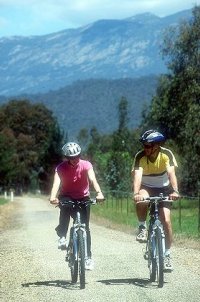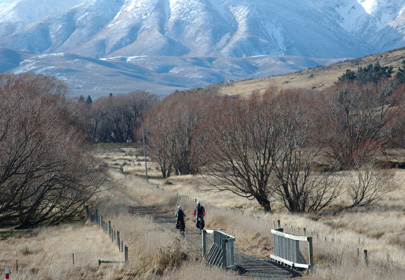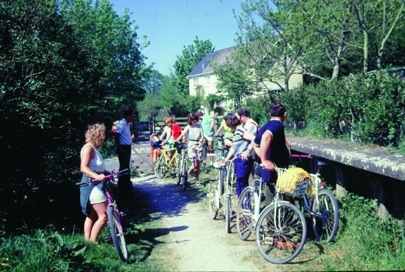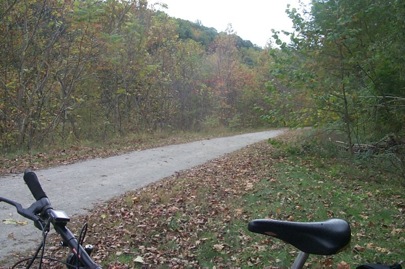Just the other day, while taking in the delights of the Lilydale-Warburton Rail Trail, the conversation turned to the tourism impact of rail trails on local communities. This sounded like an interesting topic and I thought I might look into it to discuss further here. And what do you know? The Age was right on the story the very next day:
The road to recovery for drought-stricken rural Victoria could be along a bike path, with research showing the state's regional rail trails are becoming big money-spinners.
Cyclists using rail trails — cycle and walking paths built on disused country rail lines — spend an average of $258 a day, according to a study by La Trobe University professor Sue Beeton.
I'd forgotten all about this—I actually filled in this survey while riding the Murray-to-the-Mountains Rail Trail last Easter. And (to my embarrassment) I notice that Rail Trails Australia announced the publication of Professor Beeton's full report on their site a month ago and I totally missed it.
Anyway, while cautioning against going crazy over averages, Professor Beeton gives the following break down on average expenditure per person:
| Item | Cost |
|---|---|
| Accommodation | 27.00 |
| Food & Beverage | 147.00 |
| Transport | 47.00 |
| Cycling | 10.00 |
| Other | 27.00 |
| Total | 258.00 |
On the relatively low figure for accommodation, Professor Beeton comments:
Many tourism advisors recommend focusing on smaller numbers of visitors who spend more than the 'mass' tourist, providing a greater dollar yield per person…However, often destinations consider their high yield tourist to be the one who stays in the more expensive accommodation, assuming that such expenditure will continue in all areas of their trip. This may not be the case and, as can be seen by the figures above, expenditure on accommodation on the MTM Rail Trail is not high in many cases due to the availability and use of camping grounds and caravan parks. However, these same people are spending significant amounts on food and beverages, and should be considered as a relatively high yield [market] for this trail and region.
[emphasis added]
Regarding employment, Professor Beeton continues:
According to Access Economics, every $99,000 spent by tourists creates one additional job in Victoria…The 8,300 Easter visitors alone contribute some $2,141,400 ($258.00 x 8,300) direct expenditure to the region. This represents 21.6 equivalent full-time jobs being generated by the Easter visitation.
Hmm, even if that number is off by 50% it's still pretty respectable. Indeed it appears that the possibilities of cycling-oriented tourism have not been lost on the Wangaratta Council:
The Murray to the Mountains Rail Trail project is delivering huge economic and tourism benefits to the region. The Rural City of Wangaratta is positioning itself to take full advantage of these benefits…
Professor Beeton concludes that rail trails:
provide economic opportunities for the local host communities as well as the increased pride 'showing your place' to visitors creates.
However they require not only funds to be developed, but significant maintenance support. In addition, local businesses and communities need to proactively develop, manage and promote the Trails to their markets.
In general?
It seems that such a finding is common wherever rail trails are established and popularised:
Rail-trails have economic value as a recreation resource if individuals are willing to pay to use them, either directly, through access fees, or indirectly, through travel expenditures necessary to reach and use the site. Other economic benefits…may include increased visitor spending and sales tax revenues, and business relocations due to enhanced community attractiveness…Somewhat more abstract economic and social benefits include preserving undeveloped space, enhanced community beauty, historic preservation and community pride captured by users' recreation demand for the rail-trail resource…Alternatively…potential economic and social costs of greenways should not be overlooked. These costs include site development and operation, decreased property tax revenues from putting land on the public roll and opportunity costs associated with using the land for other purposes.
Betz, Bergstrom, and Bowker (2003) "A Contingent Trip Model for Estimating Rail-trail Demand", in the Journal of Environmental Planning and Management
With all this in mind, I took a quick-and-dirty review of what's been reported in a few other countries about the economic benefits of rail trails:
New Zealand
The Otago Central Rail Trail is on New Zealand's South Island and was subject of an economic impact survey in 2005:
According to DOC, usage is growing steadily. In 2004 around 5000 people completed the full 150km challenge, with some 100,000 people movements recorded over various sections. DOC does point out that regular users in communities like Alexandra contribute to this 100,000…So is the OCRT bringing money into the region? For the answer, multiply DOC's user counts by the…2005 finding that the average per person expenditure within the Otago Central Rail Trail region was $92.80 per day (including accommodation) with the average length of stay 3.8 days.
The survey report also claims that a considerable amount of new businesses and new employment opportunities arose because of tourist traffic on that Trail.
UK
While Britain is well blessed with many general purpose trails, it seems (and I'm happy to be corrected on this) that there aren't many rail trails. There is the Camel Trail in Cornwall, which is being touted by the local council (e.g. August 2005, June 2006) as a major contributor to the local economy
, without specifying exactly how or to what magnitude.
Sustrans says:
Cycle tourism in the UK is currently valued at £635 million per year. The potential for growth here is huge - the forecast for cycle tourism right across Europe is £14 billion per year within 20 years. With potential economic benefits at this scale it is not surprising that there is keen interest in how to develop routes to attract visitors and tourists, and how to market these effectively.
But of course, they are not only referring to rail trails there.
USA
In the USA, a report from 1995 by the National Bicycle and Pedestrian Clearinghouse summarises a number of older findings about the benefits of rail rails:
There are a variety of businesses that attribute their success to nearby trail: restaurants, convenience stores, bicycle shops, campgrounds and bed-and-breakfast establishments.
And perhaps the most remarkable observation that
Homebuyers have begun to recognize the benefits of bicycle and pedestrian facilities and are showing a preference for properties close to those facilities…The increased salability of listings is considered to be the greatest value that the Northern Central Rail-Trail has brought to trailside properties in Baltimore County, Maryland. According to a 1994 study conducted for the Maryland Department of Natural Resources, "if two identical properties are for sale and one is near the trail and the other is not, the trail is used as a selling point and helps many nearby owners sell their property faster."
This is reflected in a more recent summary by the Rails-to-Trails Conservancy. They also say that
the evidence supporting the conclusion that trails and greenways improve local economies grows greater by the day. Across the United States, trails and greenways are stimulating tourism and recreation-related spending. Trail and greenway systems have become the central focus of tourist activities in some communities and the impetus for kick-starting a stagnating economy.
An example is The Great Allegheny Passage Rail-Trail which:
attracts 500,000 tourists annually, and brings economic and social benefits to an area that previously supported only heavy industry. The passage provides $15 million in direct benefits annually to communities along the trail.
Specifically:
Five new bed and breakfasts, a bike tour company, a private campground, a bike shuttle service, and a restored opera house-turned-restaurant have opened along the trail.
On track for benefits
While this is hardly a comprehensive review, it appears that Professor Beeton's findings travel well: there are generally positive economic effects that follow from the development of rail trails. (And that's not taking into account the health, environmental, and heritage benefits that may also flow.) Naturally, the set-up funding and ongoing maintenance costs can't be ignored, but my guess is that for most rail trails there is ample return on such investment.
Let's not get carried away—rail trails aren't every cyclist's cup o' tea and neither are they necessarily a panacea for regional economic woes—but I reckon I'd rather have them than not. And I'm sure plenty of regional communities are glad have them also.
Thanks Larry. I certainly don't claim to be an economist or an expert on tourism, but everything I've read suggests that rail trails are a good thing for local economies. In fact, the most surprising thing I've read is that some communities have tried to resist the conversion of rail reserves into trails…
I think it's pretty natural that rail trails are popular destinations for cycling tourists: the riding is rarely overly difficult but you can still go off-road for extended distances. And many of the towns along the old railway lines are happy to provide services to people who travel on different wheels.
So I'm not at all surprised that you've found people who've travelled some distance to ride rail trails. Professor Beeton's survey also found this, with visitors coming in from other states to ride the Murray-to-the-Mountains trail.




Comments
What a great post on the tourism value of rail trails!
In my tours on rail trails, I've met other bike tourists from far and wide. Some were camping while others were staying in hotels and B&B's but each traveler was there because of a rail trail. Naturally, other types of bike trails attract tourists too; however, abandoned rail lines are excellent candidates for spurring economic growth.
By turning a dormant rail line into a bike trail, the corridor remains intact, properties near the corridor increase in value, new businesses are started, jobs are created, and the quality of life improves. I heartily encourage leaders around the world to look upon decommissioned rail lines as the economic engines they can become.
Respectfully, Larry Lagarde RideTHISbike.com Urging bicycling for recreation, commuting, health and a better future.